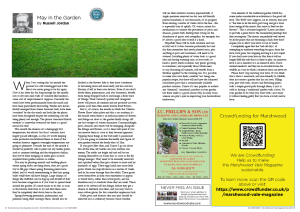
When I was writing this last month the ground was still waterlogged and it felt like it was never going to be dry again. Now it has been dry for long enough for the muddy ruts to dry into mini walls of concrete like hardness, some sort of improvement I suppose. Unusually the winds have been predominantly from the north and have been particularly desiccating. Tender new leaves, freshly emerged from winter dormant buds, have been ‘scorched’ by the dry winds and look like the plants have been droughted despite the underlying soil still being plenty wet enough. The phrase ‘mercurial British weather’ is somewhat overused but there is a good reason for that!
This month the chances of a damagingly low temperature, the elusive ‘last frost’ scenario, have largely passed although, as ever, it’s worth keeping some protective horticultural fleece to hand if the weather forecast suggests overnight temperatures are going to plummet. Towards the end of the month it should be perfectly safe to plant out any tender plants, such as summer bedding and the ubiquitous dahlias, that you’ve been bringing on under glass or have acquired from garden centres or online.
You may be planting annuals and bedding plants where spring bulbs are dying down, they are a good way to fill gaps where spring flowering plants have faded, and it’s worth remembering to feed any spring bulbs while they still have foliage. Large clumps of things like daffodils can be dug up and divided if they have become congested or if you want to spread them around the garden. It’s much easier to do this as soon as the blooms fade than to try and find them once they’ve completely died down later in the year.
Spring flowering perennials, pulmonarias and primulas being chief amongst these, should also be divided as the flowers fade as they have a tendency to becoming more and more leafy, and less and less bloomy, if left to their own devices. Even if you don’t divide them, pulmonarias, and also brunneras, benefit from being chopped back to encourage a fresh burst of foliage. Their variously spotted and variegated leaves will persist all summer and are probably an even greater asset than their much shorter lived flowers.
May is, of course, the month in which the ‘Chelsea Flower Show’ takes place and this is no accident; it’s the month when there is an embarrassment of flowers and foliage on show as the garden finally shrugs off any last vestiges of winter dormancy. Correspondingly, pests, diseases and weeds will be emerging, alongside the foliage and flowers, so it is time well spent if you can remove them as soon as they become apparent. Nipping these things in the bud really is paramount if you are going to maintain the health and vigour of your garden beyond the heady days of May.
If you grow lilies then, and I know I go on about this all the time, lily beetles are your number one enemy. The adults are bright red and will be out sunning themselves on warm days as soon as the lily foliage emerges. They need to be manually removed and squished before they get a chance to mate and lay hundreds of eggs. These eggs hatch into nasty little grubs which can strip lily leaves in a matter of weeks and do far more damage than the adults. These grubs cover themselves in their own excrement so appear as foetid blobs, rather than actual grubs, and are therefore easy to overlook when they are small. These need to be rubbed off the foliage, before they get a chance to defoliate your lilies, and you may want to wear rubber gloves for this somewhat unpleasant task.
Other pests and diseases that you spot should be removed just as ruthlessly because warm weather will see their numbers increase exponentially. A single specimen removed on day one will literally prevent hundreds, if not thousands, of its progeny from existing a matter of weeks down the line – this is especially true of aphids. Of course, nature has mechanisms to balance the prevalence of pests and diseases, parent birds feeding their young on the abundance of grubs and caterpillars for example, but it’s always a good idea to lend it a hand.
Hopefully there will be both sunshine and rain in May but if it does become particularly hot and dry then remember that newly planted areas, plus anything in pots and containers, will need to be watered. Installing plenty of water butts is a good idea and having watering cans, or hose reels, to hand is pretty much essential. Any plants growing in containers, and especially those which need to stay blooming all summer, will benefit from a fertiliser applied via the watering can. It is possible to make your own feeds, comfrey ‘tea’ being one popular recipe, but these will not have the balanced constituent parts that a commercially available product contains. I know it’s very popular to eschew any ‘chemical’, ‘unnatural’, product in your garden but there really is a good reason why, in many cases, science can play a part in improving your horticultural endeavours.
One element of the traditional garden which has come under considerable re-evaluation is the good old lawn. The ‘RHS’ now suggests, on its website, that now is “the time to let the lawn grow long and get a buzz from seeing all the insects that arrive to feed on the flowers”. This is absolute hogwash!!! Lawns are there to provide a green foil to the ornamental plantings that they accompany. The insects are perfectly well served by all the plants that are blooming in May, they don’t require you to allow your lawn to run to weeds.
I completely agree that the ‘bad old days’, of attempting to eradicate everything but grass from the lawn, have gone, but stopping mowing it is just stupid. If you don’t mow your lawn in May then it will no longer fulfil the role that it is there to play. An unmown lawn is not a meadow, it is an unmown lawn. I have created meadows and they are an absolute haven for wildlife, in a way in which a domestic lawn can never be.
Please don’t stop mowing your lawn. If you think that a lawn is unnatural, and non-friendly to wildlife, then just create a garden that has no lawn. Filling your plot with trees, shrubs and flowering plants, with a simple gravel path through them, is just as valid as having a ‘traditional’ garden with a lawn. It’s your garden to do what you want with—just enjoy it without feeling guilty that you have a lovely mown lawn.




